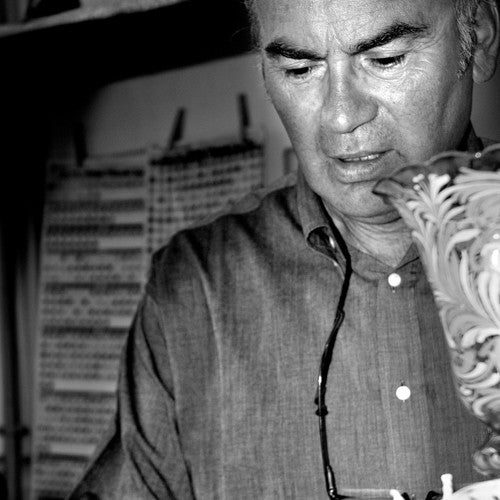Bubacco, born on Murano in 1957, began playing with glass as a boy, making small animals, beads, and the usual lamp-worker's tablet.
At fifteen he received his artisan's license and began marketing flame-worked Venetian memorabilia.
His fascination with anatomy, equine and human, lured him to push bit by bit beyond the perceived technical limits of his craft. His large free standing sculpture, worked hot and annealed during the process, is unique in lampworking made from flexible Murano soda glass canes, not less-breakable Pyrex.
His pieces challenge our notion of lampworking as a primarily decorative and whimsical, stressing as they do form and plasticity, rather than detailed elaboration and/or narrative content presented as a mini-installation. Bubacco's recent explorations with two dimensional inclusions in blown, solid off-hand and cast glass, burst forth into three dimensional glory, or are highlighted by cold working through and around the images, as he persists in his quest to create a living force in glass.
 In 1980 he began studying anatomical drawing with the Venetian artist Alessandro Rossi. His style takes on a new dimension: the movement of the figure becomes the central theme of his work.
In 1980 he began studying anatomical drawing with the Venetian artist Alessandro Rossi. His style takes on a new dimension: the movement of the figure becomes the central theme of his work.
His masterpieces are crafted in Murano glass, also called "soft glass" because of its high soda content, which is famous for its characteristic brightness and ideal for the lavorazione a lume process.
His technical experience and knowledge of glass colour compatibility allow him to create unique works: figures entirely hand-formed and incorporated in blown-vases or in casting.
For these works he availed himself of the collaboration of glass masters of the highest level, such as: Romano Donà and Stefano Toso .

His works transcend traditional uses and conceptions of the "lume" technique. They collocate motive tensions and plasticity in a context of narrative surrealism, to create highly original pieces derived from his personal sensibility.
Lucio Bubacco's sensuous works combine the anatomic perfection of Greek sculpture with the Byzantine gothic architecture of his native Venice. Seductive themes, metamorphosis and transformation, forms emerging from the void, echo themes from our mythological past when sexuality was spiritual, not political.




3 comments
Sarrazin
Bonsoir je m’appelle Angeline Sarrazin née Teixeira. Dans les année 80 je suis née en 1966 j’avais 16 ans et j’avais rencontré Lucio Bubacco qui avait 10 Andes de plus que moi. Il était à ROCAMADOUR dans le lot travaillait dans un magasin et faisait des figurines d’animaux en autres. Pouvez-vous me dire si cela peut être lui ou pas.
Sarrazin
Bonsoir je m’appelle Angeline Sarrazin née Teixeira. Dans les année 80 je suis née en 1966 j’avais 16 ans et j’avais rencontré Lucio Bubacco qui avait 10 Andes de plus que moi. Il était à ROCAMADOUR dans le lot travaillait dans un magasin et faisait des figurines d’animaux en autres. Pouvez-vous me dire si cela peut être lui ou pas.
Angeline
Dans les années 80 j’avais fais la connaissance d’un LUCIO BUBACCO à ROCAMADOUR en France. Son père était également venu. Nous avions une dizaine d’années d’écart ce qui correspondrait. Serait il possible que ce soit lui ?
Leave a comment
All comments are moderated before being published.
This site is protected by hCaptcha and the hCaptcha Privacy Policy and Terms of Service apply.